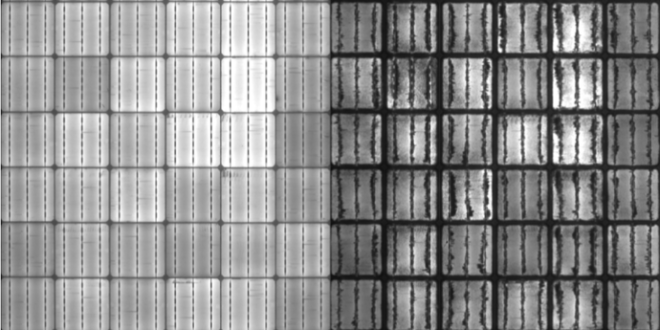With the development of renewable energy sources, photovoltaic power generation has become an increasingly popular choice. The quality and performance of photovoltaic products is the key to the future development of the industry. Amongst others, EL testing is a very important quality testing technique for photovoltaic products. This article will introduce and analyze EL testing technology.
Definition of EL testing
EL test is a non-destructive test method for photovoltaic products, the full name of the EL test is Electroluminescence (electroluminescence) test. By applying a certain voltage on the PV panel, reverse current occurs at all PN junctions in the PV panel, resulting in electroluminescence, thus obtaining the image information on the surface of the PV panel, and then judging the quality of the PV panel.
Solar panel undergoing EL testing
Significance of EL testing
Detection of product defects: EL testing can directly reflect the defects and damage inside the PV panel. For example, defects such as micro cracks, pot cracks and poor metal wire contact of PV panels will be shown in EL testing.
Improving product quality: EL testing is a fast and accurate quality inspection method that can detect defects in time and thus improve the quality of the product.
Reduce maintenance costs: EL testing can detect defects in products in time, which can avoid bigger problems in the process of use, thus reducing maintenance costs.
Principle of EL testing
The principle of EL testing is to use the photoluminescence phenomenon to collect the reverse current through the interior of the battery and then image it through the corresponding optical system.
To perform the EL test, the PV panel is placed on the EL test equipment and a reverse voltage is applied to the PV panel, which causes the PN junction to generate a reverse current, resulting in electroluminescence. The light source will illuminate the EL, resulting in a visible image, which will be captured by the camera and processed to obtain the image information of the PV panel surface.
Solar panel undergoing EL testing
Benefits of EL testing
EL testing can detect defects, damage, and flaws on the surface and inside the module by looking at the electroluminescence image of the module.
Detecting quality: EL testing can detect internal defects and surface imperfections in PV modules, enabling early detection of module quality problems, and thereby reducing the damage and impact of quality problems.
Improving performance: EL testing can identify damaged or defective cells in modules and timely identification and replacement of faulty cells can effectively improve module performance and efficiency.
Enhanced reliability: EL testing allows for a comprehensive quality inspection of PV modules before they leave the factory, reducing the failure rate and maintenance costs caused by quality issues and improving module reliability and lifetime.
Meeting standard requirements: EL testing is one of the standard test methods for PV module quality inspection and meets the requirements of international and national standards to ensure the quality and safety of PV modules.
Conclusion
EL testing allows for effective assessment of module uniformity, detection of cracks and defects in modules, and evaluation of module performance. It is important for PV manufacturers and consumers to understand the technology and principles of EL testing, as it can help them to select and produce high-quality PV products.
 HammBurg Be informed with latest news, reviews, entertainment, lifestyle tips, and much more.
HammBurg Be informed with latest news, reviews, entertainment, lifestyle tips, and much more.




